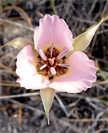 Palmer’s mariposa lily is a species of flowering plant in the lily family known by the scientific name Calochortus palmeri. It is endemic to California, where it is distributed mostly throughout the Coastal Mountain, Transverse Ranges and Peninsular Ranges of Southern California, including locations in Santa Barbara, Ventura, Los Angeles, San Bernardino, Kern, Riverside, and San Diego counties. It ranges somewhat north from the Los Angeles area to the San Francisco Bay Area, with a report of an isolated population in the Diablo Range in San Benito County.
Palmer’s mariposa lily is a species of flowering plant in the lily family known by the scientific name Calochortus palmeri. It is endemic to California, where it is distributed mostly throughout the Coastal Mountain, Transverse Ranges and Peninsular Ranges of Southern California, including locations in Santa Barbara, Ventura, Los Angeles, San Bernardino, Kern, Riverside, and San Diego counties. It ranges somewhat north from the Los Angeles area to the San Francisco Bay Area, with a report of an isolated population in the Diablo Range in San Benito County.
Palmer’s mariposa is a perennial herb producing a straight, branching stem up to 24 inches tall. The basal leaf is four to eight inches long and withers by flowering. The flower cluster bears one to six erect, open bell-shaped flowers. Each flower has three brown-speckled sepals 3 centimeters long and three wider petals each 2 to 3 centimeters long. The petals are white to light lavender and have bases with yellow or purple hairs, or no hairs, depending on the variety. There are two varieties of this species. The rarer of the two is Munz’s mariposa lily (var. munzii), being known to exist only in Riverside County.
These plants are usually bulbose and the bulb coat membranous. The stems are usually branching, straight, 3-to-6 centimeters; bearing bulblets or not. The leaves are basal withering, 1-to-2 centimeters; the blades are linear-attenuate. The inflorescences are mono-chasiate, with 1-to-4-flowered; the bracts are 1-to-2 centimeters. Flowers are erect; perianth open, broadly campanulate.
Palmer’s mariposa lily was described by Serrano Watson in 1879 on page 266 of the book, Proceedings of the American Academy. Watson’s passage on the Palmer’s mariposa lily reads: “Stem very slender, lax and flexuous, a foot or two high, 1-7-flowered, bulbiferous near the base: sepals with narrowly acuminate recurved tips, spotted; petals 6 to 12 lines long, white (or yellowish below) with a brownish claw, and with scattered hairs around the ill-defined broad densely haired gland: anthers obtuse, 3 lines long: capsule very narrow, an inch long or more. – California (near the Mohave River; n. 527 Palmer 1876).”
From: http://www.calflora.org, Wikipedia, http://www.efloras.org, http://calscape.org
SBCSentinel
News of note from around the largest county in the lower 48 states.
